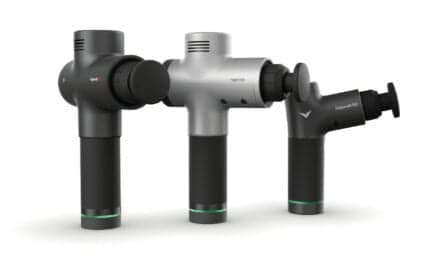Exploring a wide array of healing and pain relief applications for low-level laser therapy
By John Kelly, MPT
Increased interest in and the application of laser therapies has accelerated over the last several years, though the introduction of this modality can be traced to research beginning in the early 1960s noting photobiostimulation’s influence on wound healing. Clinicians presently utilize electrical and ultrasonic modalities, while a laser introduces light’s energy to stimulate biological activity. Increasing therapeutic intensities demonstrated promising results when the FDA cleared several devices for the treatment of carpal tunnel syndrome and head and neck pain in 2002. Low-level laser therapy (LLLT) has been introduced with promising outcomes in a variety of settings, including dentistry, veterinary, and rehabilitation medicine with therapy in wound care, joint dysfunction, pain, and inflammatory conditions.
Supportive, professional organizations, such as The North American Association for Light Therapy and World Association for Laser Therapy, as well as dedicated publications, including Photomedicine and Laser Surgery, lend credibility and a forum to discuss application. There are numerous manufacturers, including LightForce by LightCure Medical, Newark, Del, the Intelect produced by Chattanooga, a DJO Global Company, Vista, Calif, and the Winner EVO Series Stim/Ultrasound/Laser/Light Hybrid from Rich-Mar, Chattanooga, Tenn. Additional manufacturers of therapeutic lasers include Franklin, Tenn-based K-Laser’s K-Cube, the Sys*Stim from Mettler Electronics, based in Anaheim, Calif, Thor from the Hampstead, Md-based THOR Photomedicine Ltd, and the MR4, as well as the TerraQuant, manufactured by Multi Radiance Medical, Solon, Ohio, to name a few. Traditional modality interventions such as electrical stimulation, ultrasound, and radial pressure shockwave now include lasers for insertional and soft-tissue pathologies. Manufacturers offer practitioners individual clinical units or therapy equipment with combination therapies.
Electromagnetic Spectrum
The LLLT modality offers a therapeutic energy density that is nonthermal and often referred to as a “cold laser.” Utilization of a light-emitting wavelength within the infrared spectrum allows for the delivery of analgesic, vasodilatory, and anti-inflammatory properties.
What makes a laser a laser? Visible light is a portion of the electromagnetic spectrum, which is visible to the naked eye. Recall the acronym, “ROYGBIV,” from high school physics? This is the progression of visible light ranging from long to increasingly shorter wavelengths: red, orange, yellow, green, blue, indigo, violet. Cellular damage will occur to the left of the electromagnetic spectrum, and heat will be produced when moving too far to the right. The use of a ruby produced light’s first clinical application with visible red (694 nm), while the use of Helium-Neon gas (630 nm) offered more consistent, therapeutic delivery.
Specific wavelengths of light are utilized for their photobiological, photochemical, and biostimulatory effects. Laser light irradiation has unique characteristics referred to as a monochromatic, coherent, and collimated. Presently, manufacturers fill lasing chambers with the bioavailable Gallium Arsenide and Gallium Aluminum Arsenide gas (830 nm to 904 nm). Exciting atoms within this lasing medium promote the release and amplification of light, ensuring focused and consistent wavelengths.
Biological Effect
Lower-level laser energy irradiation to tissue is referred to as biostimulation, introducing energy without thermal effect. Light-absorbing components of the cells are termed chromophores or photoacceptors, and are contained within the cellular membranes. The positive effect is varied in tissue exposure. Mitochondrial stimulation results in an increase in cellular energy production. Exposed macrophages stimulate proliferation of fibroblastic activity and facilitate precursors to collagen production.
During the course of healing, lased wounds had more collagen and demonstrate higher tensile strength than the controls. Laser has been shown to enhance the degranulation of mast cells that results in histamine production. Histamine, a powerful chemical mediator, tends to accelerate the inflammatory cascade. As the inflammatory process progresses more rapidly, the proliferative phase of healing begins sooner, subsequently enhancing the wound-healing process. The effect of laser on inflammation suggests that LLLT may even begin early in the injury process and should be combined with RICE (rest, ice, compression, elevation) as an initial intervention.
Product Performance
The Laser Sys*Stim 540 from Mettler Electronics is a laser that aids in pain management by using a therapeutic infrared laser that directs pain-relieving light deep into tissues. Super luminous doses are available as well to treat larger areas with infrared light. Both types of light energy produce different health benefits, such as relief from pain and minor muscle and joint aches.
LiteCure Medical’s LightForce EX is a class IV laser designed to help clinicians achieve more consistent positive outcomes. The LightForce EX aims to facilitate fast and efficient treatments deep in the targeted tissues and features up to 15W of therapeutic power. The LightForce EX deep-tissue laser therapy system can provide demonstrated clinical therapeutic benefits to patients in a clinical setting for a wide range of both acute and chronic diseases.
Beyond the utility of a single dedicated laser are combination units, such as Rich-Mar’s Winner EVO Series, which combines the utility of e-stim and ultrasound with optional 200mW 785nm therapeutic class IIIB cold laser and combination of 500mW infrared 870nm LED and 633nm SLD light cluster.
Dosiometry
Of importance to the practitioner is the calculation of therapeutic dosage, and there is a wide array of low- to high-quality research material to assist in the decision for appropriate biostimulatory effect. Therapeutic lasers are assigned a classification dependent on their power output. Early days of light application introduced lower power and minimal tissue penetration. Very low power IIIA classifications are five times the intensity of class I and II, reaching 5.0 mW while IIIB upward 500 mW. Most clinicians offer IIIB, as there is a practical advantage in that they dramatically reduce treatment duration and enhance the treatment depth of penetration.
The Intelect Mobile Laser from Chattanooga, a DJO Global company, is another example of a class IIIB low level laser. The unit offers clinicians 17 different laser applicators, including LED, laser diodes, and clusters, as well as fully variable pulsed frequencies and real-time feedback of energy delivered. The Intelect laser also includes a menu of clinical indications specific to the laser applicator.
Pivotal Health Solutions, headquartered in Watertown, SD, also offers a class IIIB laser called the Apollo 2,000 mW Cold Laser. This is a handheld laser that can reduce pain and promote healing. The Apollo 2,000 mW Cold Laser offers portability and lightweight construction, and is the newest class IIIB cold laser in the Apollo line. The laser features a simple on-and-off switch with no programming necessary.
FDA clearance allows Class IV lasers that operate up to 10W to also have FDA clearance. There are even more powerful devices that offer deeper penetration and increased therapeutic dosage while further minimizing treatment time. However, continued research should be conducted to evaluate the integrity and type of collagen production and deposition with regard to treatment dosage. The delivery of therapeutic light varies greatly among manufacturers, and use should be carefully evaluated dependent on clinical application.
Therapeutic dose calculations are dependent on mean output power with the irradiation dose defined as the therapeutic amount of energy conducted into the tissue. Applicators are manufactured with single laser diodes as well as mixtures of visible or luminous and laser diodes. Therefore, energy calculations are dependent on total area exposed, either a small point or through larger areas. When treating surfaces (wounds, ulcers, etc), it is better to express the dose as an energy density whose unit of measure is joules per square cm (J/cm²) or local points as J/point, where watts is the delivery of joules of a period of time. Literature suggests that repeated low doses, at intervals of 1 to 7 days, induce stronger effects than the same total dose given in one treatment. This irradiation dose is not an easy calculation. It is dependent on wavelength, power, and total treatment duration and is more important than the type of laser used (visible versus invisible; pulsed exposure versus unpulsed).
Application
Epithelial effects and wound healing have been the more studied application. Skin ulcerations and oral mucositis have been shown to benefit from low-level laser exposure. Given the variety of wavelengths and dosiometry used in practice, more standardized research would improve the delivery of service, though there is more consistent evidence of therapeutic benefit with laser use in closure and wound stability.
Joint impairment and musculoskeletal hyperalgesia are conditions that have been well-studied, with diagnoses including osteoarthritis, frozen shoulder, rheumatoid conditions, and generalized back pain. Pain conditions are a primary concern in rehabilitation and medical settings. Lower back pain is a significant concern, and there have been many trials introducing this modality for analgesia and an anti-inflammatory agent. Small sample sizes and uncontrolled comparisons demonstrate inconsistent results, though data suggests there may be opportunity to minimize dysfunction and influence disablement.
Commonly used modalities used to influence pain include diathermy (ultrasound and short wave) and electrical current (various TENS waveforms and iontophoresis). Tissues have diverse densities and varied absorptive qualities. Diathermy applications influence tissue via ultrasonic vibration to encourage metabolic processes and generate heat to slacken collagen adhesions, drive medications, and provide muscular relaxation. Using surface electrodes to stimulate sensory and motor neuron depolarization, electrical stimulation attempts to provide nocioceptive inhibition, gentle muscle contractions for relaxation and decompression of congested tissue and minimization of inflammation. Iontophoresis utilizes current polarity to drive anti-inflammatory medications. Contemporary research in pain elucidates its significant biochemical and psychological complexity.
Laser irradiation appears to provide an inhibitory effect on nocioception as well as neural inhibition. Additionally, healing tissue and resolving inflammatory episodes influence chronic pain conditions. Range of motion, swelling, and overall function are captured data evaluating the effects of tissue irradiation. Interestingly, LLLT therapies have been shown to interrupt pathways responsible for reflex sympathetic dystrophy when studied in the upper extremity. Research does offer guideline applications for musculoskeletal conditions, including myofascial pain and tendinopathies for practicing clinicians.
Overall, safety concerns have been met, and the biochemistry of laser use is becoming more apparent. There are few contraindications, including over a pregnant uterus, over the eyes, over the anterior throat (thyroid gland), and using with photosensitive patients (some medications make one sensitive to light). The FDA is dependent on clinical data to validate efficacy and permit an expansion in the application of LLLT. Though efficacy does remain challenging with non-peer-reviewed publications, uncontrolled trials, and incongruous results, there is a growing body of supportive research and standardizing research methodology leaving less to interpretation and focusing the practicing clinician on relevant therapeutic application. Overall, practitioners should consider therapeutic validity through literary support, clinical experience, and patient experience when evaluating the benefit to patient care. Alternatives to corticosteroid injections and NSAIDS in laser use, when combined with exercise and manual therapy intervention, may offer a comprehensive approach to maximize patient outcomes. PTP
John Kelly, MPT, is the clinical coordinator of Siskin Hospital Therapy Services in Chattanooga, Tenn. Kelly is a graduate of the University of Florida and received his Master of Physical Therapy degree from the University of St Augustine for Health Sciences in 1992. He has a clinical focus on the cervical spine, TMJ, and myofascial pain, and is an online faculty member of Chattanooga University, author, and international course instructor in the areas of dysphagia management, low-level laser therapy, and modalities application. Kelly is a member of the American Physical Therapy Association. For more information, contact [email protected].





